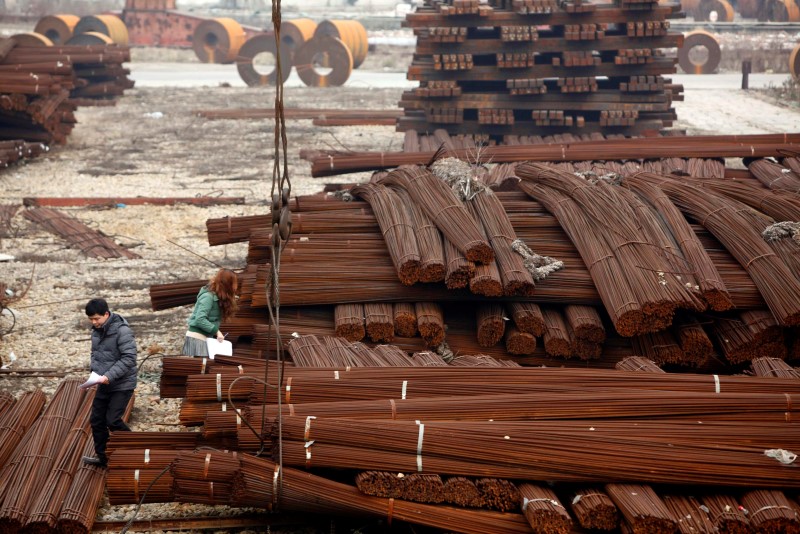--Clyde Russell is a Reuters columnist. The views expressed are his own.--
By Clyde Russell
LAUNCESTON, Australia, Aug 26 (Reuters) - One of the first steps in recovering from a debilitating condition like alcoholism is admitting you have a problem. It seems BHP Billiton (LONDON:BLT) has finally started down this path with iron ore.
In announcing a 52-percent plunge in annual profit on Tuesday, Chief Executive Andrew Mackenzie also lowered BHP's BHP.AX forecast for the peak in Chinese steel output to between 935 and 985 million tonnes by the mid-2020s.
This was down from the previously long held target of 1 to 1.1 billion tonnes that had underpinned BHP's massive expansion of its iron ore mines, which has more than doubled output in the past five years to a total of 254 million tonnes in the 2014-15 financial year.
The scaling back of BHP's China steel forecast leaves Sam Walsh, the chief executive of rival Rio Tinto (LONDON:RIO) RIO.AX , as one of the last holdouts for a peak above 1 billion tonnes.
Walsh said after releasing Rio's results, which saw a 43-percent drop in underlying earnings, that his company was "holding the line" on the 1 billion tonne by 2030 forecast, saying this represented growth of just 1 percent per year over the period.
Walsh is starting to cut a lonely figure when it comes to China's peak steel, with the market consensus increasingly swinging behind the view of the China Iron & Steel Association that the best is already behind us.
China's steel output of 823 million tonnes in 2014 may not be reached in 2015, with production in the first seven months of the year totalling 476.04 million tonnes, down 1.8 percent on the same period last year.
However, it would be a mistake to think that Mackenzie has suddenly turned bearish on China, saying he remains confident on the long-term outlook for commodities demand even though "we expect ongoing economic reforms in China to contribute to periods of market volatility".
It's also worth noting that there is still a sizeable gap between the current Chinese steel output of around 800 million tonnes and BHP's lowered forecast of as much as 985 million tonnes.
For that gap to be closed, it implies that China must accelerate from current levels in its steel consumption, in other words maintain building and manufacturing at the current rate and then on top of that, add some 20 percent more within the next 10 years.
This requires quite a strong acceleration in the sectors that consume the bulk of steel, namely housing construction, infrastructure and manufacturing.
It's worth questioning whether these sectors will indeed grow strongly in the next decade, or whether they will be struggling to keep the current level of activity constant in light of Beijing's plans to shift toward a more consumer-led service economy.
But its is also worth asking the question: what is the next logical step for companies like BHP, the world's largest miner, once they acknowledge that Chinese steel output will fall short of their prior forecasts?
IRON ORE OUTPUT STILL RISING
There wasn't any suggestion by Mackenzie or in BHP's results presentation that iron ore output will be scaled back, in fact it was forecast to rise to 270 million tonnes in the 2015-16 year, up from the 254 million in the year ended June 30.
Rather the emphasis was again on cost-cutting and control, with unit costs expected to drop to just $16 per tonne in the current financial year, from under $19 in the previous year.
This should make the cost including freight and royalties around $25 a tonne, well below the current Asian spot price of $53.30.
This will likely give Mackenzie room to argue that the strategy of maximising low-cost output in a bid to force higher-cost miners from the market still makes sense, even if demand growth for iron ore is muted.
But the financial reports make dismal reading for BHP investors, with earnings before interest and tax (EBIT) for iron ore dropping to $6.9 billion in 2014-15, down from $12.1 billion the prior year and $11.1 billion the year before that.
Dividing the iron ore EBIT by output shows that in 2012-13 EBIT per tonne was $58.74 a tonne, in 2013-14 it was $53.77 and last financial year it was $27.16 a tonne.
This clearly shows the limit of cost-cutting in the face of iron ore's drop of about 72 percent since the record high of $191.90 a tonne in February 2011.
The decline in EBIT for iron ore, which contributes about half of BHP's profit, also places a question mark over the sustainability of the company's progressive dividend policy, whereby payout to shareholders are increased annually.
This policy does go some way toward making BHP an attractive proposition from a dividend yield perspective, even if the share price has halved since April 2011.
But whether rising dividends, cost-cutting and curtailing capital expenditure will be enough remains questionable.
Much will depend on whether Mackenzie's lowered target for peak China steel output is right or still too optimistic and whether higher-cost producers finally wave the white flag and surrender by idling production.
The chances are that the first step of downgrading China's peak steel output won't be enough and BHP will have to do more to adapt to the reality of sustained low commodity prices.
The Alcoholics Anonymous programme has 12 steps, and while some aren't relevant to mining companies, it certainly takes more than just acknowledging a problem to start recovering.
Disclosure: At the time of publication Clyde Russell owned shares in BHP Billiton and Rio Tinto as an investor in a fund.
(Editing by Joseph Radford)
